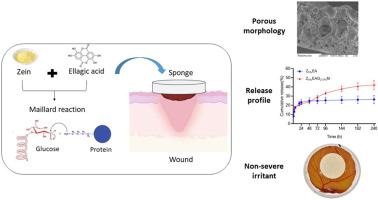玉米蛋白基海绵与葡萄糖功能化和负载鞣花酸伤口治疗
IF 4.9
3区 医学
Q1 PHARMACOLOGY & PHARMACY
Journal of Drug Delivery Science and Technology
Pub Date : 2025-09-08
DOI:10.1016/j.jddst.2025.107500
引用次数: 0
摘要
本研究旨在设计并表征葡萄糖功能化和负载鞣花酸的玉米蛋白海绵用于伤口治疗。海绵是通过一个简单的两步程序,包括匀浆和冷冻干燥的玉米-鞣花酸混合物。随后,在预冻干海绵表面加入葡萄糖溶液,在120℃烤箱中培养2 h,诱导美拉德反应。对配方进行了厚度、接触角、吸水性、溶解度、扫描电镜(SEM)、释放动力学、对接分子、生物降解性、ht - cam实验的刺激电位和对金黄色葡萄球菌的体外抗菌膜活性等方面的表征。所得的海绵具有均匀性、良好的机械阻力、高亲水性(接触角44°)和多孔表面。所有配方都具有较高的吸收能力,以及有限的溶解度,这是伤口敷料临床适用性的重要方面。葡萄糖的功能化提高了它们的溶解度和鞣花酸的释放。葡萄糖的配方表现出持续释放模式,在240小时后达到47%。分子对接显示葡萄糖和鞣花酸之间的短暂亲和力,这可能是观察到的释放增加的原因。此外,鞣花酸也有助于提高海绵的生物降解率,35天后达到40%。HET-CAM实验显示最小的刺激效应,支持其局部应用。因此,含有鞣花酸的玉米蛋白基海绵作为生物活性伤口敷料是一种很有前途的选择。它们结合了合适的形态特性、鞣花酸的可控释放、高渗出物吸收能力、低溶解度、最小的刺激潜力和快速的生物降解性,突出了它们在高级伤口护理中的应用潜力。本文章由计算机程序翻译,如有差异,请以英文原文为准。

Zein-based sponges functionalized with glucose and loaded with ellagic acid for wound treatment
This study aimed to design and characterize zein sponges functionalized with glucose and loaded with ellagic acid for wound treatment. The sponges were obtained by an easy two-step’ procedure, consisting of homogenization and freeze-drying of zein-ellagic acid mixtures. Subsequently, glucose solutions were added to the surface of the pre-lyophilized sponges, which were then incubated in an oven at 120 °C for 2 h to induce the Maillard reaction. The formulations were characterized in terms of thickness, contact angle, water sorption, solubility, scanning electron microscopy (SEM), release kinetics, docking molecular, biodegradability, irritative potential using the HET-CAM assay and ex-vivo antibiofilm activity against S. aureus. The sponges obtained presented a homogeneous aspect, appropriate mechanical resistance with highly hydrophilic (contact angles <44°) and porous surfaces. All formulations presented a high sorption capacity, together with a limited solubility, vital aspects for the clinical applicability of wound dressing materials. The functionalization with glucose enhanced their solubility and also the ellagic acid release. The formulation with glucose exhibited a sustained release pattern, reaching 47 % after 240 h. Molecular docking revealed a transient affinity between glucose and ellagic acid, which may have contributed to the increased release observed. Also, ellagic acid contributed to increase the biodegradation rate of the sponges, reaching 40 % after 35 days. The HET-CAM assay showed minimal irritant effects, supporting their topical application. Accordingly, the zein-based sponges containing ellagic acid represent a promising alternative as bioactive wound dressings. They combine suitable morphological properties, controlled release of ellagic acid, high exudate absorption capacity, low solubility, minimal irritancy potential and fast biodegradability, highlighting their potential in advanced wound care applications.
求助全文
通过发布文献求助,成功后即可免费获取论文全文。
去求助
来源期刊
CiteScore
8.00
自引率
8.00%
发文量
879
审稿时长
94 days
期刊介绍:
The Journal of Drug Delivery Science and Technology is an international journal devoted to drug delivery and pharmaceutical technology. The journal covers all innovative aspects of all pharmaceutical dosage forms and the most advanced research on controlled release, bioavailability and drug absorption, nanomedicines, gene delivery, tissue engineering, etc. Hot topics, related to manufacturing processes and quality control, are also welcomed.

 求助内容:
求助内容: 应助结果提醒方式:
应助结果提醒方式:


